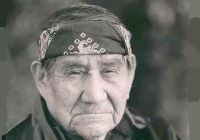
The former wife of folk artist Harrison Juan, Rena now works on her own, creating amusing and touching figures that reflect contemporary Navajo life. Her people may wear glasses, have pot bellies, or holes in a hat brim or in the seat of their pants. Rena is able to give expression to her wood figures just by the way she postures them, and often it is an expression that reveals Rena's delightful sense of humor. Rena is careful as she creates her pieces not to portray any sacred traditional Navajo symbols. 'That's the way of our culture," she explains, "to respect our elders, and nature. That's what the Dine' are taught. That's what our beliefs are."
Rena Juan - Wood Carver: Nominee of a Utah Governor's Folk Artist Award, Rena Juan has multiple talents up her sleeve that she produces when the need arises- like rug weaving and clay pottery- but wood carving is what she loves doing most, and it shows in her pieces.
Rena takes an old dead piece of cottonwood, pine, or basswood, rough cuts it with a chainsaw, then begins carving new life into it. When she is finished her carved and painted figures represent the Navajo lifestyle both in form and in spirit, creating an aura of realism, warmth, and personality.
Rena Juan sees details most people miss, and then she is able to put them into her carvings in such a way as to make them not only noticeable, but memorable. These interesting particulars are what make her carvings so lifelike. Her people may wear glasses, have pot bellies, or holes in a hat brim or in the seat of their pants. Rena is able to give expression to her wood figures just by the way she postures them, and often it is an expression that reveals Rena's delightful sense of humor.
A native of Ganado, Arizona, a place famous for rug weaving, Rena learned to weave, and sometimes makes small rugs to go with her pieces, but she finds great satisfaction in the three dimensional world of carving. She initially learned to carve professionally from watching and working with her husband. Over the past decade she has perfected her own unique style.
Rena likes to carve outdoors, in the morning air, under a small shade in her yard. (Having seven children gives her a great appreciation for the quiet of the outdoors!) Two of her sons often practice wood carving with her and they enjoy this shared time to visit.
It takes several days for Rena to "rough cut" a piece of wood, and 3 or 4 days to finish carving it. Most of Rena's tools are customized for her use. On weekends Rena enjoys traveling to art shows where she can see other's work and get new ideas for her own work. Still, Rena maintains, she gets most of her inspiration from her youth.
Rena is partial to carving sheep herders because sheep are the traditional livelihood of the Navajo. When she was a girl she and her sister spent most days of the year guarding the family flock.
"That's the center of our lives on the reservation," Rena says, "I remember when I was small we had a lot of sheep. My mom used to make us get up early in the morning. 'Come on, get up! Go herd sheep!"', Rena mimics her mother's voice with a laugh.
"We didn't go to the store every day. When we ran out of groceries we butchered sheep. We had them with wild herbs, mulberries, or cactus that my mom used to fix a certain way. We also had corn and squash."
Even then Rena carved. She created a miniature hogan and made figures of sheep, horses, and people to play with.
Rena is careful as she creates her pieces not to portray any sacred traditional Navajo symbols. 'That's the way of our culture," she explains, "to respect our elders, and nature. That's what the Dine' are taught. That's what our beliefs are."










